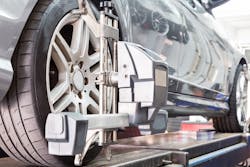According to Bob Noaker, president of Noaker’s Auto Body in Duncannon, Pa., wheel alignments are an untapped market for collision repair shops. It’s a service few shops offer—but one that can offer not only cycle time improvements, but also a separate revenue stream. Noaker’s shop, which works on 125 cars per month and does roughly $5 million in annual sales, has been performing alignments for roughly eight years. In recent years, the shop has put a greater focus on selling alignments to non-collision customers and now performs roughly 2–3 non-collision-related alignments per day. Noaker outlines how he has made wheel alignments a revenue stream in his shop.
We used to sublet out wheel alignments, but the problem we ran into was that we simply didn’t trust that there was someone out there to perform it up to our standards—especially for a vehicle that had been in a collision. Typically, we would need to do an alignment at the end of the job because most of the vehicles that needed alignments weren’t drivable. When the vehicle was done, we would outsource it and just hope that nothing would get messed up or need to be replaced. That’s really why we started doing them ourselves. It’s not so much the money you can make on it, it’s time you don’t have to spend taking the vehicle somewhere else.
Another benefit is that there are very few places in our area that can do wheel alignments, particularly when they’re involved in a collision. There are only two dealerships that offer alignments and while there are some mechanical shops around, they don’t really do alignments. The other aspect is that this is not a hard upsell. Usually around a quarter of cars need an alignment and most customers understand that they’re going to wear the tires out a whole lot quicker if they’re out of alignment, so most will do it.
As soon as the car comes in, if we know it needs an alignment or we’ve sold it as customer-pay work, we perform the alignment right away. We get it up on the alignment machine and we just take care of it because then the rest of the repair should go without a hitch. If it has suspension damage, where something is bent or torn off, we try to get those parts on the car right away and as soon as we have enough on the suspension, we’ll perform the alignment. The reason we do that is just in case there are any additional parts it may need that we don’t know about yet. Sometimes, you’ll get three or four small bent pieces that you may not physically be able to see. If you waited until the end and then found those, you could extend the repair job out another three or four days.
The other thing is that it helps with insurance companies. Often, if you can’t measure it out or don’t see physical damage, insurers don’t want to replace a part; they’d rather do an alignment, prove that there’s something bent and then replace it. That’s fine by me because we make another $80 every time they want us to do that, but it’s much more efficient to discover that up front.
We have a full-time mechanic on staff who does half off-the-street work and half auto body–related work. The scheduling can get tricky but we have two separate schedules: the auto body side and the mechanical side. If we know a job is coming in, we’ll just pencil that in on the mechanical side. The nice thing is that because alignments aren’t a lengthy service, they are nice filler work and easy to slip in throughout the day.
As far as pricing, we charge what the market will bear and typically stay in line with the market. A lot of insurance companies will dictate what you’re allowed to charge, but ironically enough, some pay us better than what we would charge off the street. Currently, we charge $80.95 for a four-wheel alignment and $64.95 for a two-wheel. Typically, barring an exception, the margins are quite good. It takes on average 10–15 minutes.
The reason we’re able to maintain such good margins is because we have an excellent alignment machine. We recently purchased a new Hunter machine that makes it quicker and easier to check for alignments. Instead of taking 10 minutes to find if a car needs something, it’s more like 2 or 3 minutes. We can check more cars going through—we now check every single car—and try to upsell alignments.
The way that we’ve been marketing wheel alignments is online. We recently switched website providers to one that focuses on automotive shops and has a lot of experience with mechanical shops. Our collision services sort of are what they are, so we have been putting more emphasis on our mechanical services online. We have been doing pay-per-click campaigns, rebuilding our website so that it’s search engine optimized and adding tabs and pages to the website highlighting our mechanical services. So far, it has made a huge difference: We’ve picked up 40 percent more mechanical work from those efforts alone.
